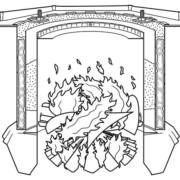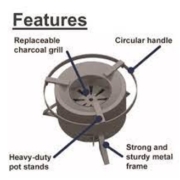by Kirk Harris
Blade cross
sectional shapes:
There are
several main physical principles that can be used to make a functional
cross-sectional shape.
- The gas enters the stationary fan
vertically from below, and should leave the fan at as flat an angle as
possible.
- Deflection: The side of the blade that faces the oncoming
gas deflects the gas to change its direction.
- A space between the blades can allow
gas to pass upward without deflecting it, reducing the stationary fans
efficiency.
- The Coanda effect can be used on the
side of the blade facing away from the oncoming gas to deflect the gas. The Coanda effect states that a stream of gas
moving parallel and close to a surface will experience a force holding it close
to the surface. This force results from Bernoulli’s
principle. The moving gas is at a lower
pressure then the atmospheric gas next to it, and so is pushed toward the
surface. The surface blocks atmospheric
pressure from pushing back.
Three shapes of blade cross-section to consider:
Straight angled
The gas on the bottom side of the
blade is moderately deflected and leaves the blade at a bad angle, reducing
swirl. The gas on the top side of the blade
cannot form a Coanda type connection to the blade because it is not flowing
parallel to the surface.
Straight bent
The gas on the bottom side of the
blade is moderately deflected, leaving the blade at a bad angle. The sharp bend in the blade slows and
disrupts the gas flow. The gas on the top
side begins by moving parallel to the blade surface, and so can attach to the
bottom half, but cannot stay connected because of the sharp bend. Sharp bends destroy the Coanda type
connection.
Smooth curve
The gas on the bottom side of the blade is fully and smoothly deflected to the horizontal direction. The gas on the top side of the blade begins by moving parallel to the surface, and so can form a Coanda attachment to the blade. Because of the Coanda effect, the gas can follow the smooth curve of the blade to a flat exit path. Note that the leading edge of the blade is at a right angle to the trailing edge.
Draft (buoyancy) vs. the Coanda effect
The gas moving horizontally on top of the blade is subject to two competing forces, the draft and the Coanda effect. The draft tries to direct the gas upward while the Coanda effect tries to keep the gas attached to the blade going horizontally. If the gas speed is slow and/or the connection of the gas to the blade is weak, the draft wins and the gas breaks away from the blade. The gas may be split between the two, some gas going each direction.
The gas deflected by the previous
blade can join the Coanda effected gas on the current blade, countering the
draft induced upward motion and improving the swirl.
Blade Construction
The simplest
stationary fan for creating swirl is made from a single round disk of sheet
metal.
There may be
4 or more blades, but I will describe a 6 bladed fan, which works best for me. Draw a small circle in the center which will
hold the blades together. Draw 6 radial
lines from the center, outside the small circle evenly spaced at 60o
each. Cut the radial lines to the small
circle. If the fan is to be mounted on a
shaft, drill a center hole of the appropriate size.
Bend the 6 blades
as shown with red lines around the point of intersection of the radial lines
with the small circle. Make the curve
smooth and round so the gas can stay connected using the Coanda effect. The lower edge of the blade should point
straight down, the upper edge horizontal.
The
stationary fan will cause flow resistance for the gasses. This will slightly reduce the highest power
level of the stove. Lower power levels
are more sensitive to flow resistance and the flame may go out. A small slit, as shown in red, can reduce the
flow resistance and allow higher and lower power flames. The blade must be bent as shown, from the end
of the slit.
There will
be an open space between the blades which will allow gasses to pass upward
without being effectively deflected, reducing swirl. This type of fan can work quite well, but can
be improved.
An improved
version which eliminates the gap can be made from two circles. Mark three evenly spaced blades at 70o on
both circles. Cut out the 50o
space between. Make a short cut on the
red lines. This will make room to place
one circle on top of the other to form one fan with 70o blades. Spot weld the two circles together in the
small center circle.
Bend the
blades as before around the red lines, but with the center at what would be the
60o blade point.
The finished
fan will not have the gaps and will be more efficient, especially for slow
moving flame gas.
Flame gasses
may escape deflection around the ends of the blade. This can cause incomplete combustion and
increased particulates. This problem may
be fixed by extending the blade beyond the flame, placing something to block
the gasses from escaping, or by raising the center of the fan and bending the
blades slightly downward as shown along the dotted lines (thus directing the
flame inward).

































